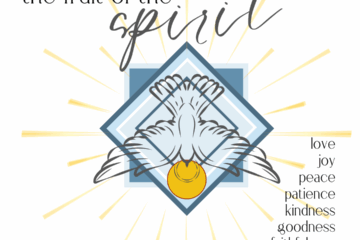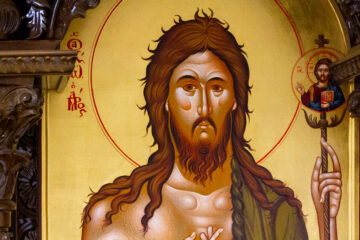On the third Sunday after Holy Pascha we hear the story of Jesus healing the Paralytic at Bethsaida (John 5:1-15). This passage is taken from what Biblical scholars have designated as “The Book of Signs,” i.e. John 1:19 through John 12. It precedes “The Book of Glory,” which deals with Christ’s Paschal Mystery (His passion, death and rising). The Book of Signs occupies much of John’s Gospel because, as Fr. Joseph Fitzmeyer notes, “It is the part of the Gospel where the Word reveals Himself to the world and is not accepted other than by His own.” In John’s Gospel, “sign” is also used to mean “miracle.” Unlike the Gospels of Mark, Matthew, and Luke, John does not record very many miracles of Jesus. There are only seven listed in John, but each tells us very special things we need to know about Jesus. The seven are: • Changing the water into wine at the wedding at Cana (John 2:1-11) • Healing the royal officer’s son (John 4:46-54) • Healing the paralytic at the pool of Bethsaida in Jerusalem (John 5:1-15) • Feeding the Five Thousand (John 6:5-14) • Walking on the Water (John 6:16-21) • Healing the man born blind (John 9:1-7) • Raising Lazarus from the dead (John 11:1-45) Each of these “signs” underscores and illustrates what is the “Mission Verse” of John’s Gospel, its over-arching theme. “For God so lived the world that He gave His only-begotten Son, that whoever believes in Him should not perish, but have everlasting life.” (John 3:16) Jesus enters the precincts of the Temple, near the five pillars, where a great pool of water stands. The pool’s name is Bethsaida, or “house of kindness and mercy” or “place of outpouring.” Dozens of sick crowded the portico waiting for the “waters to be stirred”, yet one person came within Jesus’ attention – a man who had been paralyzed for some 38 years (the number of years that the people of Israel were in exile!). Jesus asks directly, but surprisingly, “Do you want to be healed?” The man answers, “I have no one to help me into the waters.” The Lord responds “Rise, take up your mat, and walk.” After disputing with the Jews about the lawfulness of healing and carrying his mat on the Sabbath, Jesus meets the man in the Temple later and tells him “You are well; do not sin anymore, so nothing worse happens to you.” These being the major elements of the story, there are three lessons we can take from John’s passage. Thirty-eight years is a long time Imagine being paralyzed for 38 years. At the paralytic’s time. so much of life and the world were cut off to him, so many opportunities were closed. His potential was stifled the longer he couldn’t move. Living 24/7 with this physical handicap caused frustration, anxiety, and, most certainly, depression. To survive those years, he needed genuine patience, what in Biblical terms was “long-suffering.” Ironically, the origin of the word “patience” came in the 12th century from the latin “pati” or “patientia,” meaning willing to bear adversities, or calm endurance of misfortune. The paralytic knew well of that endurance. St. John Chrysostom praises the paralytic for his indefatigable determination in the face of chronic suffering. “Having come across the incident of the paralytic who lay upon his bed beside the pool, we discovered a rich and large treasure, not delving into the ground, but by diving into his heart. We found patience and hope towards God which is more valuable than any kind of jewel or source of wealth.” When Jesus lived, there were actually few cures for diseases and patiently enduring suffering was seen as somehow heroic and godly. It is more difficult for us today to be patient in the face of suffering and illness as we expect immediate and instant relief. With the dozens and dozens of pill and prescription ads on television, it is as if pain and suffering are not to be part of the human experience. Though suffering is never desired in Holy Orthodoxy, and though the Church Fathers unanimously teach that illness and suffering do NOT have their origin in God, when it occurs we are asked to endure and be patient. It can be a profitable teacher. Fr. John Breck, a theological writer, puts it this way—“More than any other experience, pain and suffering signal the fact that we are not in control. It can bring a heightened self-consciousness and an appreciation of our limitations. It draws our attention to the present moment, forces us to reorganize our life priorities, and invites us to seek above all ‘the one thing needful.” (Luke 10:42) There is little doubt but that the suffering of the paralytic tempered his spirit and increased his responsiveness and receptiveness to Jesus. Yes! He desired to be healed. Yes! He was ready. For a third of a century his soul had fought a battle with his body and was now ready to conquer. He hung on to hope and never let it die, as day after day he gazed at that pool. Jesus’ zeroing in on him above all the others waiting to be healed, was no accident. In suffering or illness, Jesus zeros in on us as well. How do I handle suffering and sickness in my life, be it physical, psychological/emotional, or spiritual? Do I do my best to hold on to hope through prayer? Do I seek out others to support me, or do I try to walk in the shadows alone? Can I see suffering and illness as “teachable moments,” not about disease but about myself, not about living in some pain-free utopia but about enduring, waiting in hope, meeting Christ in the ”pool” of my heart? We can’t do it alone. The greatest tragedy of the story of the paralytic is expressed in his words, “I have no one to put me in the pool.” Not a single person in 38 years apparently had the compassion to lift him up and place him in those healing waters. No family or friends ministered to him. Everyone who was sick rushed into the pool to be healed first and others, who were related to those suffering by love, by friendship, helped them to be healed first. If only one person had been there, if only one heart had responded with compassion, the paralytic might have been made whole years earlier. The man’s illness was capped by a profound loneliness and sense of isolation. The Germans have a saying that is appropriate here. “Pain, when shared, becomes half as bad, but pain unshared is twice as hard.” The beloved confessor of the faith, Fr. George Calciu of blessed memory, who endured torture and isolation in the Romanian communist concentration camps, wrote, “To be alone is to fall, to perish. Being alone means not thinking of anyone but yourself because you are overwhelmed by the surge of your suffering. This is because a life lived alone, if you do not have God with you, is a futile, wasted life. Life lost its meaning back in that moment when you realized, at last, that you were alone.” How often we think that there is none to lift us into the water, none to enter our pain, that there is no one to help us feel the stirring of that water. Jesus is there, arms outstretched, ready to heal us. Our sickness or suffering can push us back into ourselves so far that we can see the demon of loneliness staring us in the face. That sight can paralyze us unless we reach out to draw Jesus in, to invite another in, to reveal our vulnerability, realizing that, as St. Cyprian of Carthage tells us, “Each person falls in isolation, but we are saved in the community of the Church.” Tell others your story The paralytic took up his mat and walked away healed–after 38 years–and forgiven. Who could hold that excitement in? Who wouldn’t tell others? How could anyone be mute about such a life-changing and soul-transforming experience? How can one “take a lamp and hide it under a bushel basket?” (Matthew 5:15) The Lord calls each of us to tell our story, to relate how He touched ourlives, even in the smallest of ways, to hold us and to heal us, to lift us and to love us. Look into your own heart, think of the people in your family and your life, your friends and your fellow believers. How much frailty is there in them? How much pain has accumulated in their heart? How much fear of life, how much rejection, broken hopes, and loneliness? How long has “paralysis” held them captive? Elder Joseph of Vatopedi Monastery on Mt. Athos counsels us, “Let us look at one another with understanding, sensitivity, and with attention. We will be answerable for each other because there are so many ways in which we should be the eyes of Christ who sees the needs, the ears of Christ who hears the cry, the hands of Christ who supports and heals or makes healing possible.” Tell your story. Share your struggles. Enter the common humanity of each other to speak hope and healing. Healing is useless if it is a secret that no one knows. It’s your and my responsibility, in the name of Jesus, to reveal that secret and to perhaps “strain” to lift up another and place them in the “stirring water” of Christ’s love! Christ is Risen! Indeed, He is Risen!
ABOUT THE ORTHODOX CHRISTIAN NETWORK
Orthodox Christian Network (OCN) is a 501(c)3 and an official agency of the Assembly of Canonical Bishops of the United States of America .It is a recognized leader in the Orthodox Media field and has sustained consistent growth over twenty-two years. We have worked to create a community for both believers and non believers alike by sharing the timeless faith of Orthodoxy with the contemporary world through modern media. We are on a mission to inspire Orthodox Christians Worldwide. Click to signup to receive weekly newsletter.
Join us in our Media Ministry Missions! Help us bring the Orthodox Faith to the fingertips of Orthodox Christians worldwide! Your gift today will helps us produce and provide unlimited access to Orthodox faith-inspiring programming, services and community. Don’t wait. Share the Love of Orthodoxy Today!


0 Comments